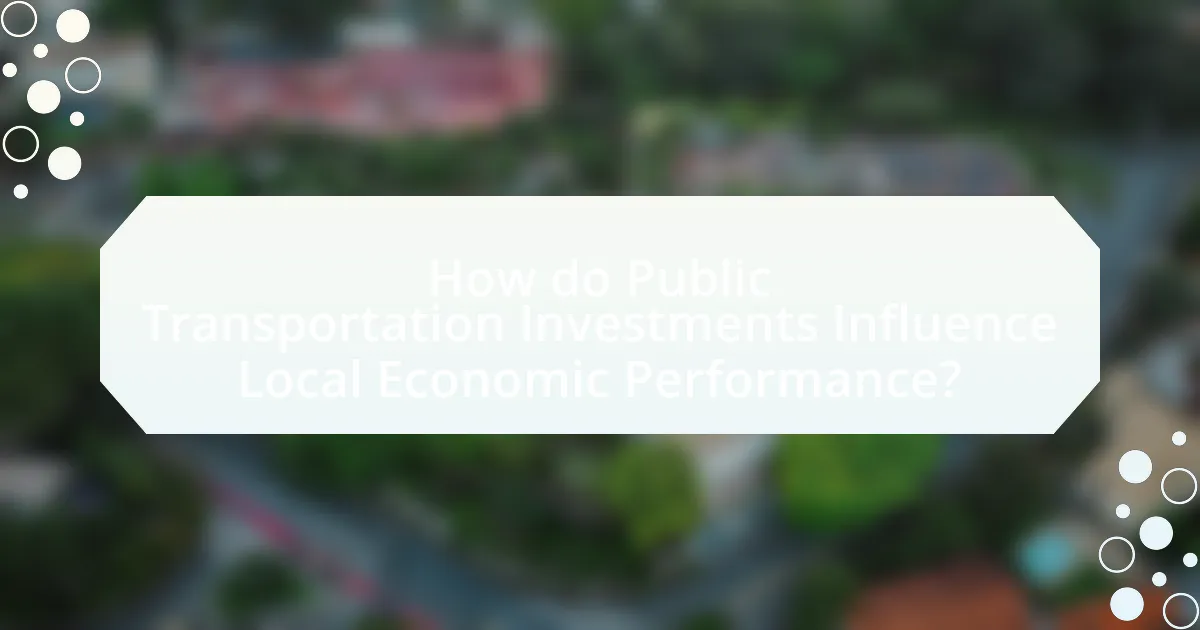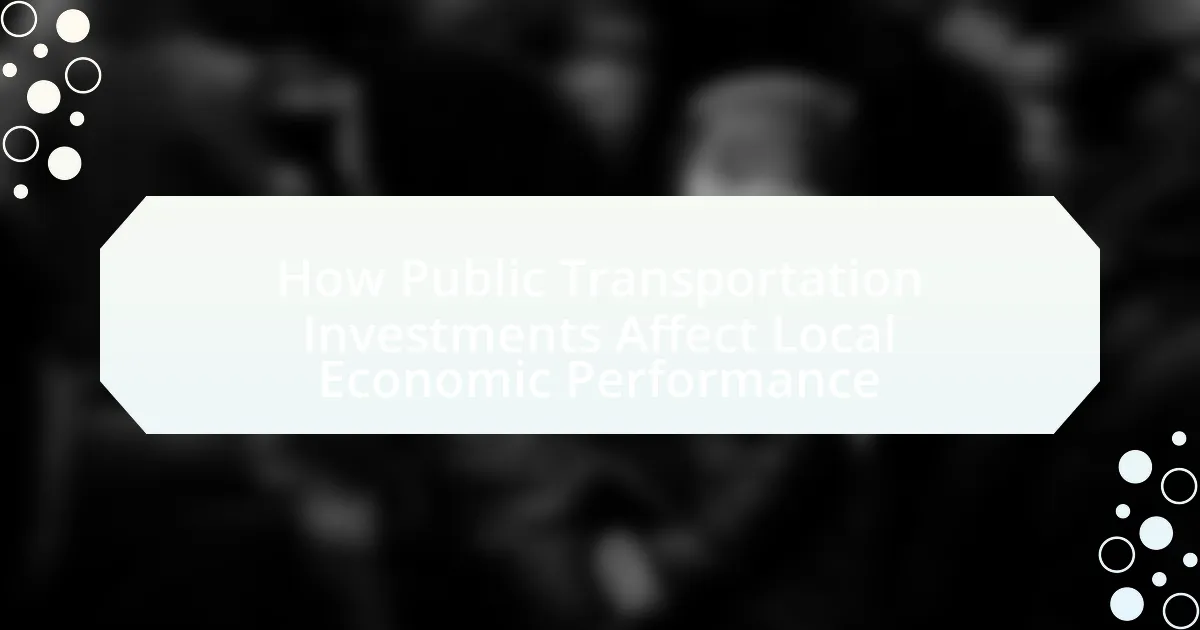Public transportation investments play a crucial role in enhancing local economic performance by improving accessibility, reducing travel times, and stimulating job creation. Key types of investments include infrastructure development, fleet expansion, technology upgrades, and service enhancements, all of which contribute to increased economic activity and property values. The article examines how these investments impact various demographics, particularly low-income communities, and discusses the long-term economic benefits, including job creation and sustainable urban development. Additionally, it highlights the importance of measuring the impact of public transportation investments through quantitative and qualitative metrics, emphasizing best practices for successful implementation.

How do Public Transportation Investments Influence Local Economic Performance?
Public transportation investments significantly enhance local economic performance by improving accessibility, reducing travel times, and stimulating job creation. Enhanced public transit systems attract businesses and residents, leading to increased economic activity. For instance, a study by the American Public Transportation Association found that every $1 invested in public transportation generates approximately $4 in economic returns. Additionally, improved transit options can lead to higher property values and increased tax revenues for local governments, further contributing to economic growth.
What are the key types of Public Transportation Investments?
The key types of public transportation investments include infrastructure development, fleet expansion, technology upgrades, and service enhancements. Infrastructure development involves constructing or upgrading transit facilities such as bus stations, rail lines, and terminals, which can significantly improve accessibility and efficiency. Fleet expansion refers to increasing the number of vehicles, such as buses and trains, to accommodate growing ridership and reduce wait times. Technology upgrades encompass implementing advanced systems for ticketing, scheduling, and real-time tracking, enhancing user experience and operational efficiency. Service enhancements involve improving frequency, reliability, and coverage of transit services, which can lead to increased ridership and economic benefits for local communities. These investments are crucial as they directly influence local economic performance by facilitating mobility, reducing congestion, and promoting sustainable development.
How do infrastructure improvements impact economic growth?
Infrastructure improvements significantly enhance economic growth by increasing productivity, reducing transportation costs, and attracting investments. For instance, improved roads and public transportation systems facilitate the movement of goods and people, leading to more efficient business operations. According to a study by the American Society of Civil Engineers, every dollar invested in public infrastructure generates approximately $3.70 in economic returns. This multiplier effect demonstrates that infrastructure not only supports existing economic activities but also stimulates new business development and job creation, ultimately contributing to a more robust economy.
What role do public transit systems play in job creation?
Public transit systems significantly contribute to job creation by enhancing accessibility to employment opportunities. They facilitate the movement of workers to various job locations, which increases the labor pool for employers and supports local businesses. According to a report by the American Public Transportation Association, every $1 invested in public transit generates approximately $4 in economic returns, including job creation. This investment leads to the development of transit-related jobs, such as construction, maintenance, and operational roles, while also stimulating job growth in sectors like retail and services that benefit from increased foot traffic.
Why is Public Transportation essential for local economies?
Public transportation is essential for local economies because it enhances accessibility, reduces traffic congestion, and stimulates economic growth. By providing reliable transit options, public transportation enables residents to access jobs, education, and services more efficiently, which in turn increases workforce participation. According to the American Public Transportation Association, every $1 invested in public transportation generates approximately $4 in economic returns, highlighting its role in fostering local business development and attracting investments. Furthermore, public transit reduces the reliance on personal vehicles, leading to decreased traffic congestion and lower transportation costs for households, which can be redirected into the local economy.
How does accessibility to public transport affect local businesses?
Accessibility to public transport significantly boosts local businesses by increasing foot traffic and customer reach. When public transport options are readily available, more potential customers can easily access shops and services, leading to higher sales volumes. A study by the American Public Transportation Association found that businesses located near public transit see a 20% increase in sales compared to those without such access. Additionally, improved public transport can enhance the overall attractiveness of an area, encouraging new businesses to open and existing ones to thrive. This correlation between public transport accessibility and business performance underscores the importance of transportation investments in fostering local economic growth.
What is the relationship between public transportation and property values?
Public transportation positively influences property values by increasing accessibility and desirability of locations. Studies have shown that properties located near public transit stations often experience higher market values; for instance, a report by the National Association of Realtors indicates that homes near public transit can sell for 20% more than similar homes located further away. This relationship is driven by the convenience public transportation offers, attracting residents who prioritize easy commuting options, thereby enhancing demand and, consequently, property values.
How do Public Transportation Investments affect different demographics?
Public transportation investments significantly affect different demographics by improving access to jobs, education, and essential services, particularly for low-income and marginalized communities. These investments often lead to increased mobility, which can enhance employment opportunities; for instance, a study by the American Public Transportation Association found that public transit can increase access to jobs by up to 30% for low-income individuals. Additionally, improved public transportation can reduce travel times and costs, benefiting those who rely on transit for daily commutes. Furthermore, demographic groups such as seniors and people with disabilities experience enhanced independence and mobility, as accessible transit options cater to their specific needs. Overall, targeted public transportation investments can bridge gaps in accessibility and economic opportunity across various demographic groups.
What impact do these investments have on low-income communities?
Public transportation investments significantly improve low-income communities by enhancing access to jobs, education, and essential services. These investments reduce travel times and costs, making it easier for residents to reach employment opportunities. For instance, a study by the American Public Transportation Association found that public transit can increase employment rates by up to 10% in areas with improved access. Additionally, better transportation options can lead to increased property values and stimulate local businesses, further contributing to economic growth in these communities.
How do public transportation improvements benefit commuters and travelers?
Public transportation improvements significantly benefit commuters and travelers by enhancing accessibility, reducing travel times, and increasing overall convenience. Enhanced public transit systems provide more reliable and frequent service, which leads to shorter wait times and quicker journeys. For instance, cities that have invested in modern transit infrastructure, such as dedicated bus lanes or light rail systems, have reported reductions in average commute times by up to 20%. Additionally, improved public transportation can lead to increased ridership, as evidenced by a study from the American Public Transportation Association, which found that every $1 invested in public transit generates approximately $4 in economic returns. This not only supports local businesses but also contributes to job creation and economic growth, demonstrating the multifaceted benefits of public transportation improvements for both commuters and travelers.
What are the long-term economic benefits of investing in Public Transportation?
Investing in public transportation yields significant long-term economic benefits, including increased accessibility, job creation, and enhanced property values. Improved accessibility allows residents to reach employment centers more efficiently, which can lead to higher workforce participation rates; for instance, studies show that every $1 invested in public transit generates approximately $4 in economic returns. Job creation occurs not only during the construction phase but also through ongoing operations and maintenance, contributing to local economies. Additionally, enhanced public transportation systems often lead to increased property values; research indicates that properties located near transit stations can see value increases of 10-20%. These factors collectively contribute to sustainable economic growth and improved quality of life in communities.
How do these investments contribute to sustainable urban development?
Public transportation investments contribute to sustainable urban development by enhancing accessibility, reducing traffic congestion, and lowering greenhouse gas emissions. These investments facilitate efficient movement of people, which encourages higher density development and mixed-use neighborhoods, leading to reduced reliance on personal vehicles. For instance, cities that have invested in public transit systems, such as Portland, Oregon, have seen a 30% increase in transit ridership, which correlates with a decrease in per capita carbon emissions. Additionally, improved public transportation can stimulate local economies by creating jobs and increasing property values near transit hubs, further promoting sustainable urban growth.
What are the potential returns on investment for local governments?
Local governments can expect significant returns on investment from public transportation projects, often yielding economic benefits that exceed initial expenditures. For instance, studies indicate that every dollar invested in public transit can generate approximately four dollars in economic returns, primarily through increased accessibility, job creation, and enhanced property values. Additionally, the American Public Transportation Association reports that public transit investments contribute to reduced traffic congestion, which saves commuters time and money, further stimulating local economies. These returns manifest in various forms, including increased tax revenues and improved local business performance, demonstrating the multifaceted economic impact of public transportation investments on local governments.
How can local governments effectively measure the impact of Public Transportation Investments?
Local governments can effectively measure the impact of public transportation investments by utilizing a combination of quantitative and qualitative metrics. These metrics include ridership statistics, economic indicators such as job creation and property values, and surveys assessing user satisfaction. For instance, a study by the American Public Transportation Association found that every $1 invested in public transportation generates approximately $4 in economic returns, highlighting the financial benefits of such investments. Additionally, analyzing changes in traffic congestion and air quality can provide insights into the broader environmental and social impacts of public transportation improvements. By systematically collecting and analyzing these data points, local governments can gain a comprehensive understanding of the effectiveness of their public transportation investments.
What metrics should be used to assess economic performance changes?
To assess economic performance changes, key metrics include Gross Domestic Product (GDP), employment rates, and productivity levels. GDP measures the total economic output and reflects overall economic health; for instance, a rise in GDP indicates economic growth. Employment rates provide insight into job creation and labor market conditions, with higher rates suggesting improved economic performance. Productivity levels, which assess output per labor hour, indicate efficiency and can signal economic advancements. These metrics collectively offer a comprehensive view of economic performance changes, supported by historical data showing that regions with increased public transportation investments often experience GDP growth and enhanced employment opportunities.
How can community feedback be integrated into evaluation processes?
Community feedback can be integrated into evaluation processes by employing structured methods such as surveys, focus groups, and public forums to gather input from residents. These methods allow stakeholders to express their views on public transportation investments, ensuring that evaluations reflect community needs and priorities. For instance, the Federal Transit Administration emphasizes the importance of public engagement in its guidelines, stating that incorporating community input leads to more effective and equitable transportation solutions. By systematically analyzing this feedback, decision-makers can adjust evaluation criteria and project goals to better align with community expectations, ultimately enhancing the impact of public transportation investments on local economic performance.
What best practices should be followed for successful Public Transportation Investments?
Successful public transportation investments should prioritize comprehensive planning, community engagement, and sustainable funding. Comprehensive planning involves assessing current transportation needs and future growth to ensure that investments align with local economic goals. Community engagement is crucial, as involving stakeholders in the decision-making process leads to better project acceptance and utilization. Sustainable funding mechanisms, such as public-private partnerships or dedicated tax revenues, ensure long-term viability and maintenance of transportation systems. Research by the American Public Transportation Association indicates that every $1 invested in public transportation generates approximately $4 in economic returns, highlighting the importance of strategic investment practices.

Leave a Reply